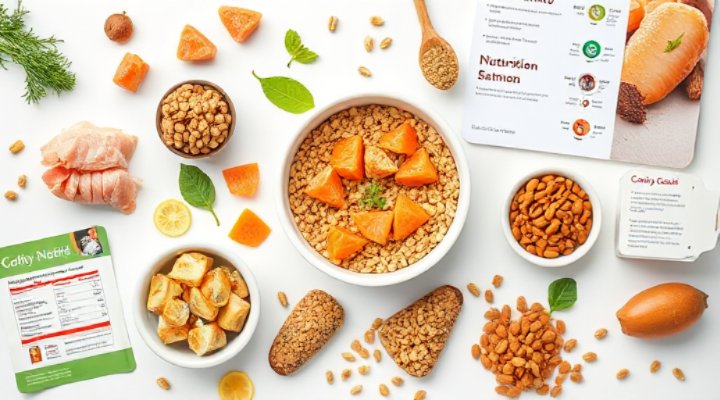Summary: Selecting the best cat food for indoor cats involves understanding their unique lifestyle and nutritional requirements. Indoor felines typically have lower energy needs but require specific support for weight management, hairball control, and urinary health. This comprehensive guide will help you navigate the complex world of feline nutrition to ensure your indoor companion receives optimal nourishment for long-term health and vitality.

Understanding Indoor Cat Nutritional Requirements
Indoor cats have distinctly different needs compared to their outdoor counterparts. Consequently, their dietary requirements must address reduced activity levels while supporting overall health. For instance, indoor cats typically need fewer calories but more specific nutrients to maintain ideal body condition. That is to say, the best cat food for indoor cats should contain controlled calorie content with enhanced fiber for digestion.
Moreover, indoor environments often lack the mental stimulation outdoor cats experience. Therefore, their food should include ingredients that support cognitive health. Additionally, proper hydration becomes crucial since indoor cats may drink less water than outdoor cats who consume moisture from prey. As a result, many veterinarians recommend incorporating wet food into their diet, as discussed in our Healthy Cat Treats Recipes Collection.
Key Ingredients to Look for in Indoor Cat Food
When searching for the best cat food for indoor cats, certain ingredients deserve special attention. Firstly, high-quality animal protein should always be the primary ingredient. Cats are obligate carnivores, meaning they require animal-based proteins for optimal health. Secondly, look for specific fibers like beet pulp or cellulose that help with hairball control—a common issue for indoor felines who groom frequently.

Furthermore, omega-3 and omega-6 fatty acids support skin and coat health, which is particularly important for indoor cats who may shed more due to consistent temperatures. Likewise, prebiotics and probiotics aid digestive health, ensuring proper nutrient absorption. Most importantly, the food should contain controlled levels of carbohydrates since indoor cats have lower energy requirements. According to the FDA’s pet food guidelines, proper labeling and ingredient transparency are essential for making informed choices.
Weight Management Strategies for Indoor Cats
Calorie Control and Portion Management
Obesity represents one of the most common health issues affecting indoor cats. Therefore, the best cat food for indoor cats should facilitate weight management through controlled calorie content. For example, many premium brands offer specifically formulated weight control recipes that provide satiety with fewer calories. Meanwhile, proper portion control remains equally important—measure meals rather than free-feeding to prevent overconsumption.
Feeding Schedule and Exercise Integration
Establishing a consistent feeding schedule helps regulate metabolism and prevent weight gain. Additionally, integrating meal times with play sessions creates positive associations with activity. Similarly, using puzzle feeders or food-dispensing toys encourages natural foraging behavior while slowing down eating pace. This approach not only manages weight but also provides mental stimulation, addressing boredom-related eating.

Addressing Common Indoor Cat Health Concerns
Indoor cats face specific health challenges that require nutritional support. Firstly, urinary tract health becomes paramount since indoor cats may be more prone to issues like FLUTD (Feline Lower Urinary Tract Disease). Consequently, the best cat food for indoor cats often includes ingredients that maintain urinary pH balance and promote hydration. Secondly, hairball management requires adequate fiber to help move hair through the digestive system naturally.
Furthermore, dental health deserves attention since indoor cats lack the natural teeth-cleaning benefits of chewing on bones or grass. Many quality indoor cat foods include dental benefits through specific kibble shapes or additives. Meanwhile, joint support becomes increasingly important as cats age, especially for breeds prone to mobility issues. For specialized health needs, consider consulting resources like the Cornell Feline Health Center for expert guidance.
Comparing Dry vs Wet Food for Indoor Cats
The debate between dry and wet food continues among cat owners seeking the best cat food for indoor cats. Dry food offers convenience and dental benefits through mechanical cleaning action. However, wet food provides crucial moisture content that supports urinary health and hydration. Ideally, a combination approach often works best, offering the benefits of both formats while keeping meals interesting for your feline friend.
Moreover, some owners choose to add water or broth to dry food to increase moisture intake. Conversely, others use wet food as a special treat or supplement. Importantly, whichever option you choose, ensure it meets the nutritional standards established by organizations like AAFCO (Association of American Feed Control Officials). For more insights on balanced feline nutrition, explore our Orijen Cat Food benefits article.

Reading and Understanding Cat Food Labels
Navigating cat food labels is essential when selecting the best cat food for indoor cats. Firstly, check the guaranteed analysis for protein, fat, and fiber percentages appropriate for indoor lifestyles. Secondly, examine the ingredient list—quality proteins should appear first, with minimal fillers or artificial additives. Additionally, look for specific life stage designations since nutritional needs change from kittenhood through senior years.
Furthermore, understanding marketing terms helps avoid misleading claims. For example, “natural” has specific regulatory meaning, while “holistic” does not. Similarly, “grain-free” may not necessarily benefit all cats unless they have specific allergies. Most importantly, consult with your veterinarian about any special dietary needs your cat might have, especially if considering prescription diets like those discussed in our Royal Canin Urinary Cat Food guide.
Transitioning to New Food Successfully
Introducing new food requires patience and proper technique to avoid digestive upset. Start by mixing a small amount of new food with their current food, gradually increasing the proportion over 7-10 days. This gradual transition allows your cat’s digestive system to adapt while giving them time to accept the new taste and texture.
During the transition period, monitor your cat’s appetite, energy levels, and litter box habits. Any significant changes might indicate the need to slow the transition or reconsider the food choice. Remember that cats can be creatures of habit, so persistence and positive reinforcement often yield the best results when changing diets.

Creating a Complete Nutritional Plan
Beyond selecting the right food, establishing a comprehensive nutritional plan ensures your indoor cat thrives. This includes proper feeding schedules, fresh water availability, and appropriate treat management. Treats should constitute no more than 10% of daily calorie intake and ideally complement their main diet nutritionally.
Additionally, consider environmental factors that affect eating behavior. Quiet, low-traffic feeding areas reduce stress during meals. Elevated bowls can improve digestion for some cats, while multiple feeding stations help in multi-cat households. Regular weight checks and body condition scoring help adjust portions as needed, ensuring your cat maintains optimal health throughout their life stages.
For those interested in supplementing commercial diets, our Homemade Cat Treats for Training offers healthy alternatives that can be incorporated into your cat’s nutritional plan without compromising their balanced diet.
Monitoring Health and Adjusting Nutrition
Regular observation remains crucial when feeding the best cat food for indoor cats. Monitor coat condition, energy levels, and litter box habits as indicators of nutritional adequacy. Weight should be checked monthly, with adjustments made to feeding amounts if needed. Senior cats particularly require close monitoring as their metabolic needs change with age.
Furthermore, annual veterinary check-ups help identify any developing health issues that might necessitate dietary changes. Blood work can reveal nutritional deficiencies or excesses before they manifest physically. Keeping a feeding journal noting food amounts, brand changes, and your cat’s response can provide valuable information for your veterinarian when assessing nutritional adequacy.
Related Keywords: indoor cat nutrition, premium cat food brands, weight management cat food, hairball control formulas, urinary health cat food, senior cat nutrition, grain-free cat food, limited ingredient diets, high protein cat food, digestive health cat food

